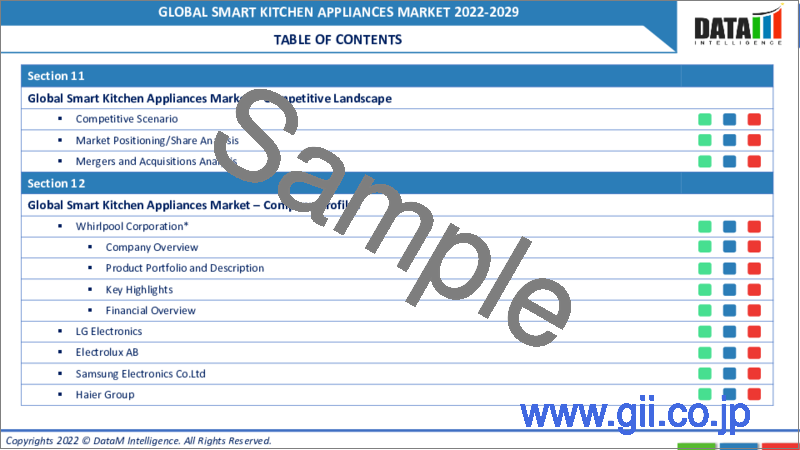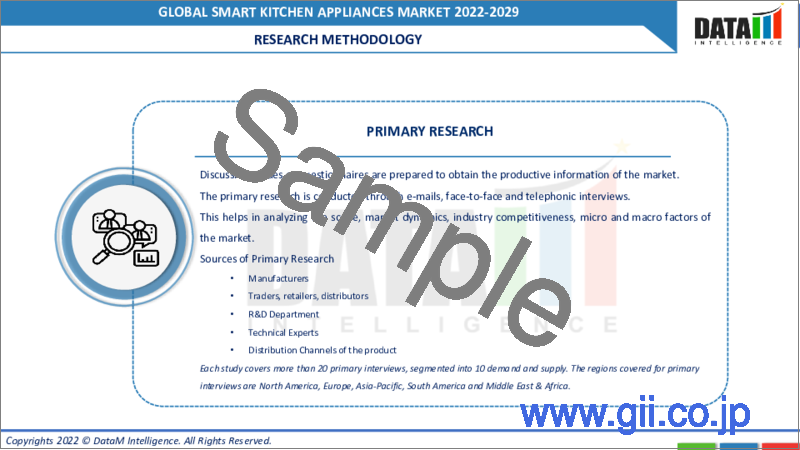|
|
市場調査レポート
商品コード
1082932
スマートキッチン家電の世界市場(2022年~2029年)Global Smart Kitchen Appliances Market - 2022-2029 |
||||||
|
● お客様のご希望に応じて、既存データの加工や未掲載情報(例:国別セグメント)の追加などの対応が可能です。 詳細はお問い合わせください。 |
|||||||
| スマートキッチン家電の世界市場(2022年~2029年) |
|
出版日: 2022年06月03日
発行: DataM Intelligence
ページ情報: 英文 180 Pages
納期: 約2営業日
|
- 全表示
- 概要
- 目次
スマートキッチン家電部門は、世界の生活水準とスマートホーム設備への関心の高まりによって牽引されています。また、ユーザーフレンドリーなインターフェースを備えた高エネルギー効率の家電製品の需要も、キッチン家電の購入を後押しする要因となっています。
当レポートでは、世界のスマートキッチン家電市場について調査分析し、市場概要、市場分析、競合情勢、企業プロファイルなど、体系的な情報を提供しています。
目次
第1章 世界のスマートキッチン家電市場:範囲と調査手法
- 調査手法
- 市場の範囲
第2章 世界のスマートキッチン家電市場:主要な動向と開発
第3章 世界のスマートキッチン家電市場:エグゼクティブサマリー
- 市場内訳:製品タイプ別
- 市場内訳:用途別
- 市場内訳:流通チャネル別
- 市場内訳:地域別
第4章 世界のスマートキッチン家電市場:市場力学
- 市場に影響を与える要因
- 促進要因
- 抑制要因
- 市場機会
- 影響分析
第5章 世界のスマートキッチン家電市場:業界分析
- ポーターのファイブフォース分析
- バリューチェーン分析
- 特許分析
- 規制分析
第6章 世界のスマートキッチン家電市場:COVID-19分析
- 市場でのCOVID-19の分析
- COVID-19以前の市場シナリオ
- 現在のCOVID-19の市場シナリオ
- COVID-19以後・将来のシナリオ
- COVID-19における価格力学
- 需要と供給のスペクトル
- パンデミック時の市場に関連する政府のイニシアチブ
- メーカーの戦略的イニシアチブ
第7章 世界のスマートキッチン家電市場:製品タイプ別
- イントロダクション
- 市場規模分析・前年比成長分析:製品タイプ区分別
- 市場魅力指数:製品タイプ区分別
- スマート冷蔵庫
- イントロダクション
- 市場規模分析(2020年~2029年)・前年比成長分析(2021年~2029年)
- スマートオーブン
- スマート食器洗い機
- スマート圧力鍋
- その他
第8章 世界のスマートキッチン家電市場:用途別
- イントロダクション
- 市場規模分析・前年比成長分析:用途区分別
- 市場魅力指数:用途区分別
- 住宅
- イントロダクション
- 市場規模分析(2020年~2029年)・前年比成長分析(2021年~2029年)
- 商業
第9章 世界のスマートキッチン家電市場:流通チャネル別
- イントロダクション
- 市場規模分析・前年比成長分析:流通チャネル区分別
- 市場魅力指数:流通チャネル区分別
- ホームセンター専門店
- イントロダクション
- 市場規模分析(2020年~2029年)・前年比成長分析(2021年~2029年)
- 電気・電化製品店
- オンライン販売
- その他
第10章 世界のスマートキッチン家電市場:地域別
- イントロダクション
- 市場規模分析・前年比成長分析:地域別
- 市場魅力指数:地域別
- 北米
- イントロダクション
- 主要な地域固有の力学
- 市場規模分析・前年比成長分析:製品タイプ別
- 市場規模分析・前年比成長分析:用途別
- 市場規模分析・前年比成長分析:流通チャネル別
- 市場規模分析・前年比成長分析:国別
- 南米
- イントロダクション
- 主要な地域固有の力学
- 市場規模分析・前年比成長分析:製品タイプ別
- 市場規模分析・前年比成長分析:用途別
- 市場規模分析・前年比成長分析:流通チャネル別
- 市場規模分析・前年比成長分析:国別
- 欧州
- イントロダクション
- 主要な地域固有の力学
- 市場規模分析・前年比成長分析:製品タイプ別
- 市場規模分析・前年比成長分析:用途別
- 市場規模分析・前年比成長分析:流通チャネル別
- 市場規模分析・前年比成長分析:国別
- アジア太平洋
- イントロダクション
- 主要な地域固有の力学
- 市場規模分析・前年比成長分析:製品タイプ別
- 市場規模分析・前年比成長分析:用途別
- 市場規模分析・前年比成長分析:流通チャネル別
- 市場規模分析・前年比成長分析:国別
- 中東・アフリカ
- イントロダクション
- 主要な地域固有の力学
- 市場規模分析・前年比成長分析:製品タイプ別
- 市場規模分析・前年比成長分析:用途別
- 市場規模分析・前年比成長分析:流通チャネル別
第11章 世界のスマートキッチン家電市場:競合情勢
- 競合シナリオ
- 競合他社の戦略分析
- 市場ポジショニング・シェア分析
- 合併・買収の分析
第12章 世界のスマートキッチン家電市場:企業プロファイル
- Whirlpool Corporation
- 企業概要
- 製品群・ 品目
- 主要なハイライト
- 財務概要
- LG Electronics
- Electrolux AB
- Samsung Electronics Co.Ltd
- Haier Group
- Panasonic Corporation
- KitchenAid
- Thermador
- Fisher & Paykel
- General Electric
第13章 世界のスマートキッチン家電市場:重要考察
第14章 世界のスマートキッチン家電市場:DataM
Market Overview:
The global smart kitchen appliances market is valued at USD XX million in 2021 and is forecasted to reach USD XX million by 2029, growing at a CAGR of XX% during the forecast period (2022-2029).
Smart kitchen appliances are integrated with various sensors that make operation simple for users. Furthermore, some smart kitchen appliances are equipped with connectivity characteristics that allow them to communicate with other household appliances and handheld devices such as smartphones, tablets, and other similar devices. These appliances can also be controlled remotely by consumers. The smart kitchen appliances sector is driven by global living standards and a growing interest in smart-linked home equipment. Another element driving kitchen appliance purchases are the demand for energy-efficient appliances with user-friendly interfaces.
Market Dynamics:
Increasing demand for luxury and tech-savvy appliances, as well as technological advancements in kitchen appliances
The smart kitchen appliance industry has benefited from increased technology integration, such as Artificial Intelligence (AI) and the Internet of Things (IoT), and an increase in people's disposable income. On a global scale, smart kitchen equipment is becoming increasingly used in both the household and commercial sectors. This is one of the major factors driving the market for smart kitchen appliances to grow. Additionally, convenience, intelligent sensors, linked security features, and time-saving features are key aspects expected to propel the global smart kitchen appliances market forward. Kitchen appliance manufacturers have recognized the promise of IoT and are investing time and money in establishing infrastructures for their goods to interact across. Consumers actively using IoT devices value this feature, which is projected to fuel market expansion throughout the forecast period. The Internet of Things (IoT) is a developing network of common objects that connects industrial machinery with consumer home appliances to share information and accomplish tasks. At the same time, people are busy doing other things. Small amounts of computational power embedded in appliances have resulted in major lifestyle benefits. By alerting users of schedules, deadlines, or other household demands, networked devices are better serving users and helping to adjust their behavior in good ways. With the rapid growth of technology, the kitchen concept has undergone a significant transformation, with a strong focus on enhancing efficiency in the kitchen and lowering the time spent cleaning and cooking.
Devices upgraded with smart sensors and Internet of things (IoT) enabled technologies have helped the market gain traction. Over the forecast period, IoT devices are also expected to boost market expansion. Customers on the global market have begun to associate technical innovation with wealth, and they are spending a disproportionate amount of money on home decoration. As a result, the market for smart kitchen equipment has grown globally. Every new appliance, from dishwashers to freezers, incorporates smart technology to provide tailored functionality for various customer demands and preferences. The development of smart kitchens is aided by the trend toward smaller single-family homes and integrated kitchen designs. Smart devices are useful not just for their convenience and ease of use but also for their environmental benefits. Connected domestic appliances, for example, can keep shopping lists and check what is still in the refrigerator with a single glance on the smartphone.
Market Segmentation:
Smart refrigerators is dominating segment in global smart kitchen appliances market
Smart refrigerators dominated the market in terms of value in 2021, with a XX% share. Increased spending on home upgrades in the residential sector, as well as the expanding cook-at-home trend, are driving sales of smart kitchen equipment. The increased popularity of the smart home idea has resulted in an increase in demand for smart kitchen appliances, which has benefited the kitchen appliance business. The most popular kitchen appliances are smart refrigerators. Smart refrigerators can alter the temperature, operate the water dispenser, and use the embedded touchscreen. Stainless steel has a smooth surface that is easy to maintain and durable. Another high-end trend is to incorporate appliances with cabinetry using custom panels. Higher-end appliances have the advantage of having classic lines that blend in with various kitchen styles.
Based on the distribution channel, residential applications held the highest market revenue share of XX% in 2021. Consumers are becoming more interested in buying high-end smart kitchen appliances due to a growing attraction to cooking as a result of increased awareness through popular culinary shows broadcast on television. Furthermore, expanding tourism and travel increases consumers' interest in other cooking cultures and multi-cuisine food, prompting them to use smart kitchen appliances for their homes. According to a recent NPR investigation, around 39 million Americans own a smart speaker for usage in a linked home. Voice-activated speakers and smartphone interfaces can control kitchen equipment such as refrigerators and ovens from afar. Samsung's new BESPOKE 4-Door Flex refrigerator features a brand-new Beverage Center that includes an Autofill Water Pitcher that is always full of fresh water, an ultra-hygienic water dispenser, and a Dual Ice Maker that can make both ordinary ice and "ice chunks" to cold drinks even faster.
Geographical Penetration:
North America is dominating region in global smart kitchen appliances market
In 2021, North America had the highest share of XX percent. This can be attributed to a growth in smart grid projects, shifting customer preferences, and increased purchasing power. Increased government incentives for using energy-efficient gadgets are key factors driving the industry. As the number of residential and commercial construction projects in this region rises, regional demand for smart kitchen equipment will expand. During the forecast period, Asia Pacific will be the fastest-growing segment. Increased internet usage and technological improvements in developing economies such as China and India are to blame for this. According to the China Internet Network Information Center (CNNIC), China has a 59.3 percent internet penetration rate. Smart appliance adoption is expected to increase due to new product advancements across the sector. In China, for example, Xiaomi Global Community debuted a fully autonomous smart washing machine in December 2018.
Competitive Landscape:
The smart kitchen appliances market is fragmented. The smart kitchen appliances market is competitive and comprises numerous regional and international competitors. Furthermore, while engaging the consumers with innovation and expansion strategies, key players capitalize on the market revenue. Several well-known players dominate the market. These firms command a significant market share and have a global presence. To gain market share, manufacturers are deciding on new product launches. For example, in June 2021, the Guangdong-based Midea Group unveiled a new refrigerator on Huawei's HarmonyOS. Users can take advantage of various functions provided by the smart appliance. This includes touch-based interactions that may tell consumers how fresh the goods in the refrigerator are at any particular time.
COVID-19 Impact:
Positive impact on the global smart kitchen appliances market
Home appliances are increasingly making their way into shopping trolleys as individuals in the Covid world spend more time at home. While the lockdowns caused some instability in the business, overall consumer sentiment has been strong, and the prognosis is positive. E-commerce sites have begun to generate significant income in recent years, particularly following COVID-19. The ubiquity of smartphones and tablets with quick payment methods has further aided the growth of the online home appliances business. Manufacturers reset inventory positions by offering discounts to clear away spring and summer stockpiles. Digital marketing is crucial in this situation for retaining engagement and increasing online sales, and attracting people to visit stores in those geographic markets once they reopen.
Why Purchase the Report?
- Understand the current market scenario and viability of global smart kitchen appliances market over the forecast period
- Visualize the composition of the global smart kitchen appliances market in terms of product type, application and distribution channel to identify major players, growth potential, and market strategies
- Identify the key regulations prevailing in the market and understand their impact on the market over the forecast period
- Understand the key business factors such as market competition, product pricing, new product developments, and patent filings pertaining in the market
What we offer?
- PDF report with the most relevant analysis cogently put together after exhaustive qualitative interviews and in-depth market study
- Excel data sheet with valuable data points of the global smart kitchen appliances market - Regional and Country level segmentation
- Product mapping in excel for the key products of all major market players
- Market Share Analysis covering business revenues ($) and revenue share (%) of key market players
The global smart kitchen appliances market report would provide an access to approximately 45 market data tables, 45 figures and 180 pages.
Target Audience:
- Food and Beverage Companies
- Kitchen Appliances Manufacturers
- Industry Investors
- Education & Research Institutes
- Research Professionals
Table of Contents
1. Global Smart Kitchen Appliances Market -Scope and Methodology
- 1.1. Research Methodology
- 1.2. Scope of the Market
2. Global Smart Kitchen Appliances Market -Key Trends and Developments
3. Global Smart Kitchen Appliances Market - Executive Summary
- 3.1. Market Snippet by Product Type
- 3.2. Market Snippet by Application
- 3.3. Market Snippet by Distribution Channel
- 3.4. Market Snippet by Region
4. Global Smart Kitchen Appliances Market - Market Dynamics
- 4.1. Market impacting factors
- 4.1.1. Drivers
- 4.1.2. Restraints
- 4.1.3. Opportunities
- 4.2. Impact analysis
5. Global Smart Kitchen Appliances Market - Industry Analysis
- 5.1. Porter's five forces analysis
- 5.2. Value chain analysis
- 5.3. Patent Analysis
- 5.4. Regulatory Analysis
6. Global Smart Kitchen Appliances Market - COVID-19 Analysis
- 6.1. Analysis of Covid-19 on the Market
- 6.1.1. Before COVID-19 Market Scenario
- 6.1.2. Present COVID-19 Market Scenario
- 6.1.3. After COVID-19 or Future Scenario
- 6.2. Pricing Dynamics Amid Covid-19
- 6.3. Demand-Supply Spectrum
- 6.4. Government Initiatives Related to the Market During Pandemic
- 6.5. Manufacturers Strategic Initiatives
7. Global Smart Kitchen Appliances Market - By Product Type
- 7.1. Introduction
- 7.1.1. Market size analysis, and y-o-y growth analysis (%), By Product Type segment
- 7.1.2. Market attractiveness index, By Product Type segment
- 7.2. Smart Refrigerators*
- 7.2.1. Introduction
- 7.2.2. Market Size Analysis, US$ Million, 2020-2029 And Y-O-Y Growth Analysis (%), 2021-2029
- 7.3. Smart Ovens
- 7.4. Smart Dishwashers
- 7.5. Smart Pressure Cooker
- 7.6. Others
8. Global Smart Kitchen Appliances Market - By Application
- 8.1. Introduction
- 8.1.1. Market size analysis, and y-o-y growth analysis (%), By Application segment
- 8.1.2. Market attractiveness index, By Application segment
- 8.2. Residential*
- 8.2.1. Introduction
- 8.2.2. Market Size Analysis, US$ Million, 2020-2029 And Y-O-Y Growth Analysis (%), 2021-2029
- 8.3. Commercial
9. Global Smart Kitchen Appliances Market - By Distribution Channel
- 9.1. Introduction
- 9.1.1. Market size analysis, and y-o-y growth analysis (%), By Distribution Channel Segment
- 9.1.2. Market attractiveness index, By Distribution Channel Segment
- 9.2. Specialty Home improvement Stores*
- 9.2.1. Introduction
- 9.2.2. Market Size Analysis, US$ Million, 2020-2029 And Y-O-Y Growth Analysis (%), 2021-2029
- 9.3. Electronics and Electrical Appliance Stores
- 9.4. Online Sales
- 9.5. Others
10. Global Smart Kitchen Appliances Market - By Region
- 10.1. Introduction
- 10.1.1. Market Size Analysis, And Y-O-Y Growth Analysis (%), By Region
- 10.1.2. Market Attractiveness Index, By Region
- 10.2. North America
- 10.2.1. Introduction
- 10.2.2. Key region-specific dynamics
- 10.2.3. Market Size Analysis, And Y-O-Y Growth Analysis (%), By Product Type
- 10.2.4. Market Size Analysis, And Y-O-Y Growth Analysis (%), By Application
- 10.2.5. Market Size Analysis, And Y-O-Y Growth Analysis (%), By Distribution Channel
- 10.2.6. Market Size Analysis, And Y-O-Y Growth Analysis (%), By Country
- 10.2.6.1. U.S.
- 10.2.6.2. Canada
- 10.2.6.3. Mexico
- 10.3. South America
- 10.3.1. Introduction
- 10.3.2. Key Region-Specific Dynamics
- 10.3.3. Market Size Analysis, And Y-O-Y Growth Analysis (%), By Product Type
- 10.3.4. Market Size Analysis, And Y-O-Y Growth Analysis (%), By Application
- 10.3.5. Market Size Analysis, And Y-O-Y Growth Analysis (%), By Distribution Channel
- 10.3.6. Market Size Analysis, And Y-O-Y Growth Analysis (%), By Country
- 10.3.6.1. Brazil
- 10.3.6.2. Argentina
- 10.3.6.3. Rest of South America
- 10.4. Europe
- 10.4.1. Introduction
- 10.4.2. Key Region-Specific Dynamics
- 10.4.3. Market Size Analysis, And Y-O-Y Growth Analysis (%), By Product Type
- 10.4.4. Market Size Analysis, And Y-O-Y Growth Analysis (%), By Application
- 10.4.5. Market Size Analysis, And Y-O-Y Growth Analysis (%), By Distribution Channel
- 10.4.6. Market Size Analysis, And Y-O-Y Growth Analysis (%), By Country
- 10.4.6.1. Germany
- 10.4.6.2. U.K.
- 10.4.6.3. France
- 10.4.6.4. Spain
- 10.4.6.5. Italy
- 10.4.6.6. Rest of Europe
- 10.5. Asia Pacific
- 10.5.1. Introduction
- 10.5.2. Key Region-Specific Dynamics
- 10.5.3. Market Size Analysis, And Y-O-Y Growth Analysis (%), By Product Type
- 10.5.4. Market Size Analysis, And Y-O-Y Growth Analysis (%), By Application
- 10.5.5. Market Size Analysis, And Y-O-Y Growth Analysis (%), By Distribution Channel
- 10.5.6. Market Size Analysis, And Y-O-Y Growth Analysis (%), By Country
- 10.5.6.1. China
- 10.5.6.2. India
- 10.5.6.3. Japan
- 10.5.6.4. Australia
- 10.5.6.5. Rest of Asia Pacific
- 10.6. Middle East and Africa
- 10.6.1. Introduction
- 10.6.2. Key Region-Specific Dynamics
- 10.6.3. Market Size Analysis, And Y-O-Y Growth Analysis (%), By Product Type
- 10.6.4. Market Size Analysis, And Y-O-Y Growth Analysis (%), By Application
- 10.6.5. Market Size Analysis, And Y-O-Y Growth Analysis (%), By Distribution Channel
11. Global Smart Kitchen Appliances Market - Competitive Landscape
- 11.1. Competitive scenario
- 11.2. Competitor strategy analysis
- 11.3. Market positioning/share analysis
- 11.4. Mergers and acquisitions analysis
12. Global Smart Kitchen Appliances Market -Company Profiles
- 12.1. Whirlpool Corporation*
- 12.1.1. Company Overview
- 12.1.2. Product Portfolio and Description
- 12.1.3. Key Highlights
- 12.1.4. Financial Overview
- 12.2. LG Electronics
- 12.3. Electrolux AB
- 12.4. Samsung Electronics Co.Ltd
- 12.5. Haier Group
- 12.6. Panasonic Corporation
- 12.7. KitchenAid
- 12.8. Thermador
- 12.9. Fisher & Paykel
- 12.10. General Electric
- List not Exhaustive*
13. Global Smart Kitchen Appliances Market - Premium Insights
14. Global Smart Kitchen Appliances Market - DataM
- 14.1. Appendix
- 14.2. About us and services
- 14.3. Contact us




